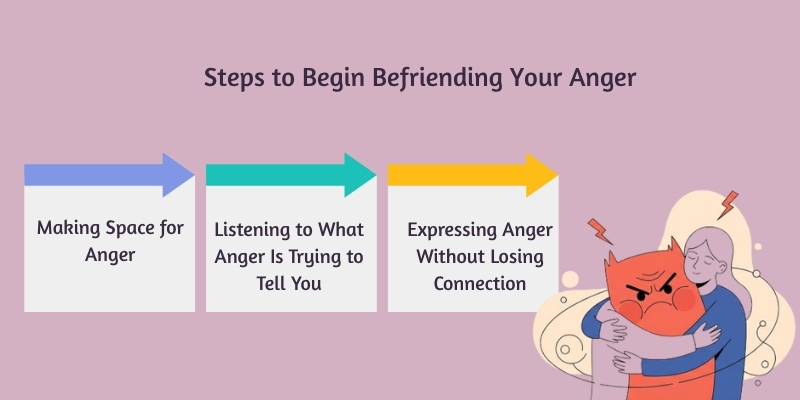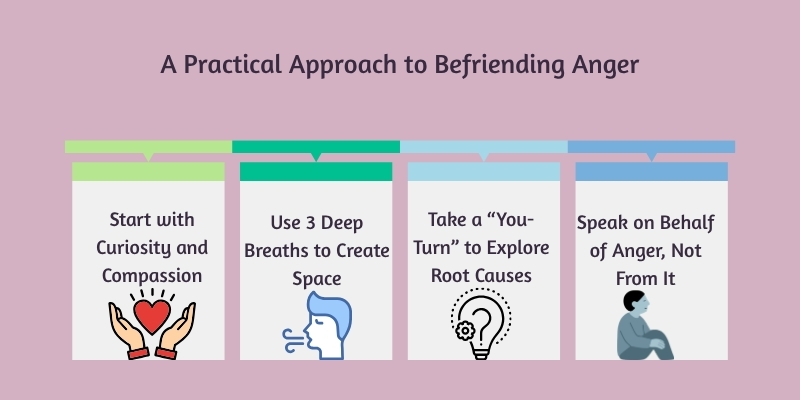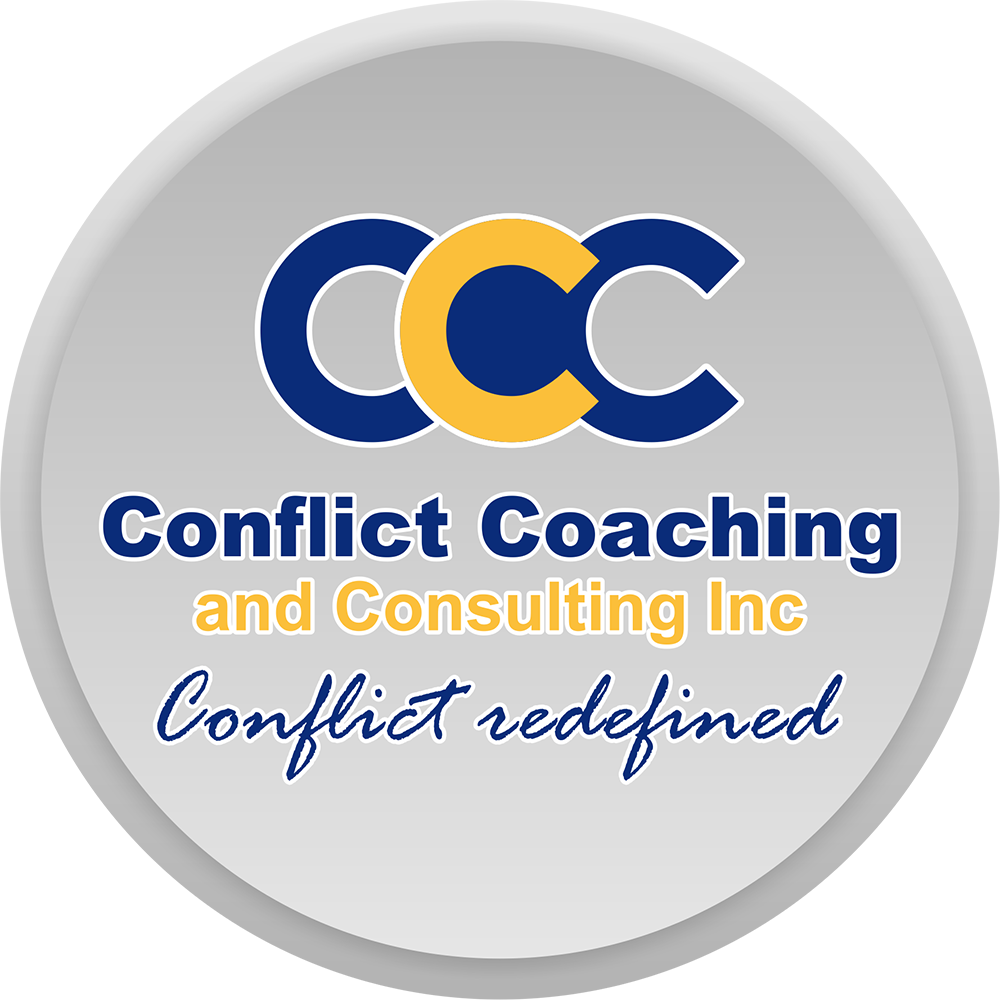
Befriending Anger: Transforming Fear into Strength
Anger is a natural human emotion, but for many, it can feel overwhelming or even destructive.
According to a National Library of Medicine study, about 7.8% of Americans experience some form of anger management issue, with a significant number of people admitting to frequent outbursts or struggles with controlling their temper. Yet, anger doesn’t have to be the enemy.
Befriending anger is about understanding it rather than suppressing it, learning what it has to teach us about our boundaries, unmet needs, and deeper emotions.
When we view anger as something to fear or avoid, it can lead to emotional turmoil, from anxiety and depression to issues with relationships.
But by taking a mindful approach, we can transform anger into a powerful tool for personal growth and connection.
This blog will explore how to befriend your anger, offering practical steps to turn this often misunderstood emotion into a source of strength, resilience, and emotional clarity.
It’s time to stop letting anger control us and start using it as a guide to live a more balanced and empowered life.
How We Were Taught to Fear Anger, Not Befriend It
From a young age, many of us are taught that anger is something to be avoided or suppressed.
Cultural and familial teachings often paint anger as a dangerous emotion, something that leads to harm, conflict, or loss of control.
In some households, expressions of anger are met with harsh discipline or shame, creating a deep-rooted belief that anger is inherently bad.
This mindset can follow us into adulthood, leaving us feeling guilty or ashamed when anger arises, even though it’s a natural human response.
For many of my clients, this fear of anger manifests in beliefs like, “Anger means I’m out of control” or “Nice people don’t get angry.”
These thoughts reinforce the idea that expressing anger is wrong or unacceptable, leading to emotional suppression.
Unfortunately, this avoidance doesn’t make anger go away—it often results in passive aggression, unresolved resentment, or even physical symptoms of stress.
By shifting our perspective and seeing anger as a signal rather than an enemy, we can begin to break free from these limiting beliefs and learn to engage with anger in a healthier, more constructive way.
The Cost of Refusing to Befriend Anger

Imagine a client, Sarah, who has always prided herself on being the “nice” person. She avoids conflict at all costs, suppressing her anger whenever it arises.
At work, she takes on extra tasks to avoid upsetting her colleagues, and at home, she constantly puts the needs of others ahead of her own.
Over time, Sarah’s inability to express her anger leads to feelings of resentment. She feels overwhelmed, exhausted, and disconnected from those around her, but she struggles to pinpoint the cause.
Sarah’s story is a common one for many who deny their anger. While suppressing anger may seem like a way to keep the peace, it often comes at a high price.
Unaddressed anger can manifest in passive-aggressive behavior, such as sarcasm, withdrawing from relationships, or quietly resenting those who unknowingly contribute to our stress.
This emotional suppression doesn’t just affect relationships; it also takes a toll on mental health.
Research links suppressed anger to increased levels of anxiety and depression, as the pent-up emotions begin to manifest in physical and emotional exhaustion.
By refusing to acknowledge and process anger, Sarah and many others like her are left with a lingering sense of disconnection and emotional fatigue.
Recognizing and addressing anger, rather than suppressing it, can help restore balance and improve both mental and emotional well-being.
3 Steps to Begin Befriending Your Anger

Befriending your anger is a journey of understanding, not suppressing. It involves three key steps that help you approach this emotion with curiosity and compassion.
These steps will guide you in acknowledging your anger, understanding what it’s trying to communicate, and expressing it in ways that foster connection rather than conflict.
By following these steps, you can transform anger from a destructive force into a tool for self-awareness and healthy boundaries.
1. Making Space for Anger
The first step to befriending your anger is to make space for it.
Rather than pushing it away or pretending it doesn’t exist, allow yourself to sit with the feeling. This requires observing your anger without judgment, simply acknowledging its presence.
You don’t need to act on it immediately, but rather, take a moment to feel and name the emotion.
This mindful observation allows you to sit in discomfort and begin understanding the root cause of your anger. It’s important to recognize that feeling anger is human, and giving it space to exist is the first step toward healing.
2. Listening to What Anger Is Trying to Tell You
Once you’ve made space for your anger, it’s time to listen to what it has to say.
Instead of viewing anger as something dangerous, reframe it as information—it’s a signal that something needs attention.
Anger often arises when our needs are unmet, boundaries are violated, or our values are challenged.
Ask yourself, “What is my anger protecting?” Is it a need for respect? Is it a response to injustice? By reframing anger in this way, you can begin to identify what is truly at the heart of the emotion.
Understanding the message behind your anger gives you the power to address the underlying issue and take healthier actions.
3. Expressing Anger without Losing Connection
The final step in befriending your anger is expressing it in a way that doesn’t damage relationships. Healthy expression of anger involves being honest without being harmful.
You can start by using “I feel” language to communicate your emotions, such as “I feel frustrated when…” This technique takes responsibility for your feelings while avoiding blame.
Journaling can also be a helpful tool for processing anger, allowing you to express your thoughts and reflect on them.
Body awareness, such as deep breathing or physical grounding techniques, can help you stay calm while expressing your anger.
A Practical Approach to Befriending Anger

Befriending anger isn’t just about acknowledging it; it’s about creating a healthy, mindful relationship with it.
This practical approach helps you manage anger in a way that fosters understanding, compassion, and emotional growth. Here are some actionable steps you can take to begin the process:
1. Start with Curiosity and Compassion
The first step to befriending your anger is approaching it with curiosity and compassion.
Instead of judging yourself for feeling angry, recognize that this emotion is valid and part of being human.
When anger arises, pause for a moment and ask yourself: “What am I feeling, and why?” By observing your anger without judgment, you create space to understand its deeper roots.
This mindset allows you to approach your anger as a messenger rather than an enemy, giving you the chance to learn from it.
2. Use 3 Deep Breaths to Create Space
Anger often triggers a physical reaction in the body, which can cloud your judgment and lead to impulsive actions.
To create space between the feeling of anger and your response, take three deep breaths. This simple act calms the nervous system, slows your heart rate, and helps you regain control.
By grounding yourself through deep breathing, you create the opportunity to respond thoughtfully instead of reacting impulsively. The more you practice this, the better you’ll become at remaining calm in the face of anger.
3. Take a “You-Turn” to Explore Root Causes
Instead of focusing on the immediate situation that triggered your anger, take a “You-Turn” to explore where the anger is coming from.
Ask yourself: “What triggered me?” and “Is this anger coming from the present moment, or is it tied to something in my past?”
This reflection helps you uncover underlying emotions that may be fueling your anger, such as past trauma, unmet needs, or unresolved conflicts.
Understanding the root causes and 3 R’s of your anger enables you to address the deeper issues and prevents you from projecting unresolved pain onto current situations.
4. Speak on Behalf of Anger, Not From It
The final step is to express your anger thoughtfully. Instead of letting anger dictate your words or actions, speak on behalf of it.
Use language that acknowledges your feelings without attacking others. For example, say, “I feel frustrated because…” rather than “You always…”
This helps you communicate the message of your anger without escalating the situation. By speaking from a place of understanding, you allow your anger to be heard without it taking over.
Healthy expression of anger not only supports your emotional well-being but also nurtures respect and connection with others.
The Hidden Gifts of Befriending Anger
While anger is often seen as destructive or uncontrollable, when we befriend it, we unlock powerful gifts that can strengthen our sense of self and improve our relationships.
Anger, when understood and channeled properly, can become a source of wisdom, protection, and personal growth. Let’s explore the hidden gifts of befriending anger.
1. Anger as the Honorable Sentry
Anger is often seen as a chaotic force, but when managed properly, it can serve as an honorable sentry—a wise protector, guarding our emotional boundaries and values.
Just as a sentry watches over a castle, anger protects us from emotional harm and ensures that our needs are being met.
Instead of being a destructive force, anger is a tool that allows us to stand up for ourselves and others, reinforcing self-respect and justice.
When we understand this role, anger becomes a powerful, protective ally rather than something to fear or suppress.
Anger’s Gifts
- Conviction: Anger strengthens our resolve to stand up for what is important, giving us the courage to act in alignment with our values.
- Boundaries: Anger clearly defines our emotional limits, allowing us to set healthy boundaries and assert our needs.
- Self-Respect: Expressing anger in a healthy way affirms our worth, letting others know that we expect to be treated with dignity and respect.
- Justice: Anger often arises when we see or experience injustice, serving as a catalyst for action and change.
- Vitality: Anger provides the energy and drive to take action, defend ourselves, and advocate for what we believe in.
How Anger Protects Not Just Self, but Others
Anger can protect not only our own boundaries but also the rights and well-being of others. For example, standing up against injustice or advocating for someone who is being mistreated is often driven by anger.
In this way, anger becomes a powerful force for positive change, not only in our own lives but also in the lives of others.
2. When You Have Too Little or Too Much Anger
Like any emotion, anger must be in balance to be effective.
Too little anger can result in people-pleasing behavior, while too much anger can create rigidity, isolation, and explosive behavior, causing harm to ourselves and others.
Finding a middle ground—where anger is expressed healthily and constructively—is crucial to maintaining emotional well-being and healthy relationships.
Too Little Anger
- Enmeshment: When we don’t express anger, we may lose a sense of self, becoming overly focused on others’ needs and neglecting our own.
- Low Self-Worth: Suppressing anger can make us feel invisible, as we may believe that our emotions don’t matter or that we are unworthy of standing up for ourselves.
- Burnout: Constantly putting others’ needs first and avoiding confrontation can lead to emotional exhaustion and burnout.
Too Much Anger
- Rigidity: Excessive anger can lead to inflexibility, where we become stuck in our views and unable to adapt to new situations or perspectives.
- Isolation: Constantly expressing anger in destructive ways can push people away, leading to social isolation and damaged relationships.
- Explosive Patterns: Having too much anger may result in sudden outbursts or aggression, making it difficult to maintain control or communicate effectively.
The Importance of Balance and Emotional Skillfulness:
Healthy emotional expression involves finding balance—enough anger to protect and assert ourselves, but not so much that it causes harm or overwhelms us.
Learning to manage and express anger skillfully is key to emotional health.
This requires emotional awareness, self-regulation, and a willingness to address the root causes of anger in a thoughtful way.
3. Letting Anger Flow Freely
Free-flowing anger is anger that is expressed in a calm, present, and aware way. It is not about suppressing or ignoring the emotion, but rather acknowledging it, understanding it, and allowing it to pass through us without overwhelming us or causing harm.
Skillfully managed anger can strengthen our relationships, as it allows us to communicate our needs clearly and assertively without aggression or violence.
Healthy anger works quietly, like a loyal guardian, protecting our values and promoting positive change without causing destruction.
Free-Flowing Anger
- Calm: Free-flowing anger arises when necessary but is expressed calmly, without getting overwhelmed by emotion.
- Present: It is felt in the moment, not as a result of repressed or past issues, and is processed with mindfulness.
- Aware: With awareness, we understand why we are angry and what action it calls for, rather than reacting impulsively.
How Skillfully Managed Anger Strengthens Relationships and Restores Vitality
When anger is expressed mindfully, it becomes a tool for healthy communication. It helps us establish clear boundaries and advocate for ourselves without damaging relationships.
By expressing anger in a way that is calm and respectful, we build trust and emotional intimacy in our relationships.
This allows anger to restore our vitality, giving us the energy and courage to take action while maintaining respect and connection with others.
Healthy Anger as a Quiet Guardian
Healthy anger does its job quietly, much like a loyal guardian, alerting us to danger without overwhelming us.
It is there to protect our values and needs, and when expressed with awareness, it leads to growth, connection, and emotional resilience. Free-flowing anger, when managed with skill, helps us create a life of balance and emotional integrity.
Conclusion
Befriending anger doesn’t mean letting it control us—it means recognizing it as a valuable partner in our emotional toolkit.
When we stop fearing anger and begin to understand its message, it becomes a source of strength, clarity, and growth.
By welcoming anger into our lives with mindfulness and compassion, we can establish clearer boundaries, communicate with emotional honesty, and form deeper connections with others.
Rather than being something we suppress or avoid, anger can guide us to what truly matters—our values, our needs, and our personal integrity.
It empowers us to stand up for ourselves and others, protecting what is important in our relationships and in the world around us.
Ultimately, befriending anger is a path to wholeness, not destruction. When we learn to work with our anger, it strengthens our emotional resilience and creates a foundation for healthier, more authentic interactions.
Anger, when respected and expressed constructively, becomes an ally in our journey toward self-awareness and emotional well-being.





Responses